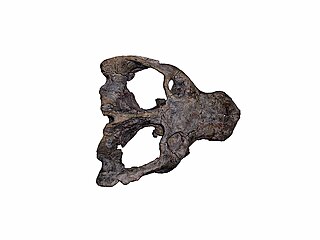History
In 1935, in the District of Vale-Vêneto, José Pivetta and Valentim Zamberlan started taxidermy in the museum, which is already part of the same collection.
In 1959, due to lack of space in Vale-Vêneto, the museum transferred to the College Máximo Palotino in Santa Maria. Moreover, in 1964, Daniel Cargnin, contributing to the museum in the college, collected various objects and fossils of geopark of paleorrota. On 7 January 1965, the museum received the first fossil, excavated in the Paleontological Site Sanga of Alemoa, near the town of Santa Maria. From this date, its growth continued, thanks especially to the efforts of Daniel Cargnin and Abraão Cargnin.
During the years 1972 to 1994, the museum personnel received several donations of the community in general and collections of sites: archaeological and palaeontological. During these years, the Museum Vicente Pallotti became a large repository of objects, and for this reason, the entire collection was in precarious conditions. Then in 1994, aiming to solve the difficulties, the museum was given its first phase of reorganization that continued until 1998. In 1998, work began on the second phase of reorganization.

Friedrich von Huene born Friedrich Richard Freiherr von Hoyningen-Huene was a German nobleman paleontologist who described a large number of dinosaurs, more than anyone else in 20th century Europe. He studied a range of Permo-Carboniferous tetrapods. He worked at the collections of the institute and museum for geology and paleontology at the University of Tübingen.

The Federal University of Santa Maria is a Brazilian public university located in Santa Maria, in the state of Rio Grande do Sul, funded by the federal government of Brazil. It was founded in 1960, by Professor José Mariano da Rocha Filho. Its campuses span over 1,837.72 ha, with a total of 386,968 m2 of buildings and 28,307 students.

Unisinos is a Brazilian private Jesuit university founded in 1969. Its main campus is located in Southern Brazil, in the city of São Leopoldo, state of Rio Grande do Sul. Unisinos has more than 30,000 students in its 91 undergraduate programs, 19 academic master's programs, 6 professional master's programs, and 14 PhD programs, with six schools – Polytechnic, Business, Law, Health, Creative Industry, and Humanities.

The Paleontological Site Arroio Cancela is located within the city of Santa Maria, a municipality of Rio Grande do Sul, the southernmost state of Brazil. The site is situated in the neighbourhood Nossa Senhora de Lourdes at an altitude of 107 metres above sea level. The fossils have been discovered within the sediments of the Santa Maria Formation, they are vertebrates from the Triassic period and are about 225 million years old.

Paleontological Site Jazigo Cinco is located in the city of Santa Maria, Rio Grande do Sul, Brazil. And belongs to Santa Maria Formation. It is located in the neighborhood Kilometro 3 near Castelinho, is to 2.7 kilometers away from the Paleontological Site Arroio Cancela. It belongs to UFSM and is a center of research. It is the place where he was collecting the Staurikosaurus, the first Brazilian dinosaur. Site belongs to the region paleorrota.

The Sanga da Alemoa paleontological site is located in the city of Santa Maria, Rio Grande do Sul, in Brazil. It belongs to the Caturrita Formation and the Santa Maria Formation. It is located in the neighborhood of Castelinho. The site belongs to the paleorrota region.

The Palaeontological Site Chiniquá is located in the Brazilian municipality of São Pedro do Sul, Rio Grande do Sul, along highway BR-287, about 70 kilometers west of the city of Santa Maria. The site occupies an area of about 250 hectares and is part of the geopark of paleorrota. It yielded fossils of Middle Triassic (Ladinian) age.

The Aristides Carlos Rodrigues Museum is located at Avenue Pereira Rego, 1000, in the town of Candelária, in the state of Rio Grande do Sul, Brazil. It is a museum of Geopark of Paleorrota with information on the region. It was inaugurated in July 2001.

Daniel Cargnin (1930–2002) was a Brazilian priest and amateur paleontologist born in Nova Palma, in the state of Rio Grande do Sul, Brazil, in 1930. He died in 2002, and at his request was buried in the town of Mata.
The Institute of Geosciences is a unit of instruction of the Federal University of Rio Grande do Sul (UFRGS). It includes the undergraduate courses of Geography, Geomatics Engineering, Geology. It has a department of study of vertebrate paleontology which has made great contributions to the geopark of Paleorrota.
Protuberum is an extinct genus of traversodontid cynodonts known from a single species Protuberum cabralense, from the Middle Triassic of Brazil.

Edwin Harris "Ned" Colbert was a distinguished American vertebrate paleontologist and prolific researcher and author.
Guilherme Rau (?–1953) immigrated to Santa Maria, Rio Grande do Sul, Brazil from Germany in 1900. An ophthalmologist, from 1915 to 1917 he helped with the Geological Survey of Berlin's excavation of 200 fossil at the Paleontological Site Sanga of Alemoa. He also contributed considerably to the Geopark of Paleorrota and taught Botany at the Faculty of Pharmacy of the city in the years 1934 and 1935.
João Guilherme Fischer, also known as Jango Fischer was a Brazilian diplomat and scientist.
Atílio Munari was a Brazilian paleontologist.
Vicentino Prestes de Almeida was a Brazilian paleontologist.

Rudolf Stahlecker was a German geologist and biology teacher.
Romeu Beltrão (1913–1977), was a Brazilian physician, educator, historian and paleontologist. He was born and died in Santa Maria, Rio Grande do Sul, Brazil.

The Museu de Ciências Naturais da Fundação Zoobotânica do Rio Grande do Sul, is a Brazilian museum located inside the Porto Alegre Botanical Garden. Open from Monday to Sunday 9am to 12pm and from 13h30 to 17h.

The Paleontological Sites of Santa Maria are located in the city of Santa Maria, Rio Grande do Sul, Brazil and dating from the Triassic. Are in the Santa Maria Formation and Caturrita Formation.













